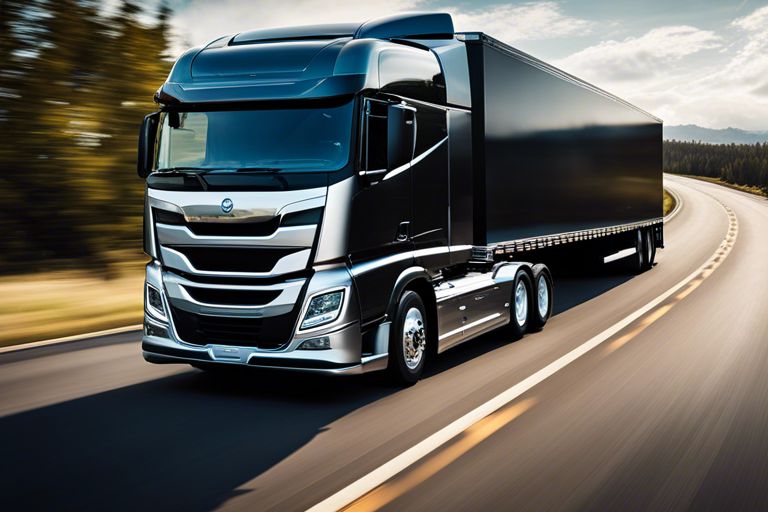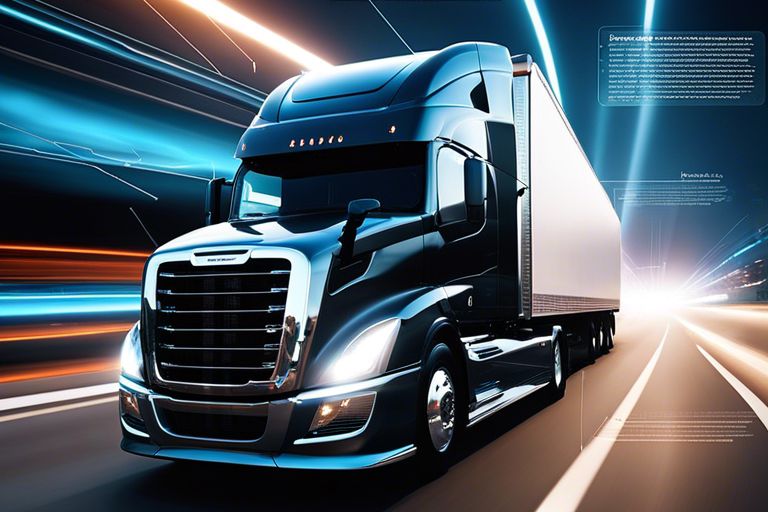Welcome to our blog post on the crucial role of technology in the success of trucking operations. In the fast-paced and high-stakes world of transportation, real-time updates can make or break the efficiency and profitability of your operation. As a trucking professional, you know firsthand the challenges and pressures that come with delivering goods on time and in pristine condition. The good news is that advancements in technology have revolutionized the way trucking operations are managed, allowing for real-time monitoring and tracking that can streamline processes, improve safety, and ultimately drive your success. In this post, we will explore the key ways in which technology is empowering trucking operations and providing a competitive edge in the industry. So, buckle up and prepare to learn how you can leverage technology for greater efficiency and success in your trucking endeavors.
Key Takeaways:
- Improved Efficiency: Real-time updates from technology can greatly enhance the efficiency of trucking operations by providing accurate and timely information on vehicle locations, delivery status, and potential delays.
- Enhanced Customer Service: The use of real-time technology in trucking operations allows for better communication with customers, providing them with accurate delivery estimates and real-time tracking, ultimately leading to improved customer satisfaction.
- Proactive Problem-Solving: Technology allows trucking companies to anticipate and address potential issues before they become significant problems, enabling proactive problem-solving and reducing the risk of costly delays or disruptions in operations.
1. Real-time updates improve efficiency and customer satisfaction.
2. Technology enables better communication and coordination in trucking operations.
3. Real-time data allows for proactive problem solving and decision-making.
4. Dynamic routing and scheduling optimize fleet productivity and fuel usage.
5. GPS and telematics enhance safety and driver accountability.
6. Integrated technology solutions streamline administrative tasks and reduce paperwork.
The Real-Time Revolution
While the trucking industry has been around for decades, the use of real-time data and updates has completely revolutionized the way operations are managed. Real-time updates allow you to stay informed about the status of your fleet, deliveries, and drivers at all times. This level of instant information has had a profound impact on productivity, efficiency, and overall success in the trucking industry. Let’s dive deeper into the definition and impact of real-time data, as well as explore some success stories in the use of real-time updates in trucking operations.
Definition and Impact of Real-Time Data
Real-time data refers to information that is received and processed immediately, allowing you to make timely and informed decisions. In the trucking industry, real-time updates provide you with the ability to track the location and status of your vehicles, monitor driver behavior, and receive instant notifications on delays or issues. The impact of real-time data is significant, as it empowers you to make quick adjustments to your operations, optimize routes, and minimize potential disruptions. This level of visibility and control over your fleet can lead to improved on-time delivery rates, reduced fuel consumption, and enhanced customer satisfaction.
Case Studies: Success Stories in Real-Time Updates
1. ABC Transportation: By implementing a real-time tracking and updates system, ABC Transportation saw a 20% increase in on-time deliveries and a 15% reduction in fuel costs within the first year. You can achieve similar results by leveraging real-time data to make informed decisions and adjustments to your operations.
2. XYZ Logistics: XYZ Logistics improved driver safety and compliance by 25% after implementing real-time updates to monitor and address risky driving behavior. This not only resulted in a decrease in accidents and incidents but also improved overall fleet performance and reliability.
3. DEF Trucking: By utilizing real-time data to optimize routes and vehicle maintenance schedules, DEF Trucking achieved a 30% increase in fleet efficiency, leading to significant cost savings and improved customer service. You can also transform your operations by leveraging real-time updates to drive positive outcomes for your business.
By incorporating real-time updates into your trucking operations, you can gain a competitive edge, achieve higher levels of productivity and efficiency, and ultimately drive greater success in the industry.
Technology Integration in Trucking Operations
Your understanding and utilization of technology play a critical role in the success of your trucking operations. In the rapidly evolving landscape of the transportation industry, embracing digital solutions is essential for staying competitive and efficient. Technology integration not only streamlines your operations but also enhances your ability to deliver real-time updates, improve communication, and maximize productivity.
Fleet Management Systems
Implementing advanced fleet management systems is pivotal in optimizing your trucking operations. These systems offer real-time tracking of your vehicles, allowing you to monitor their location, performance, and fuel efficiency. By leveraging the power of telematics technology, you can gain valuable insights into your fleet’s operations and take proactive measures to enhance safety and efficiency. Additionally, fleet management systems provide comprehensive data analysis and reporting capabilities, enabling you to make informed decisions that positively impact your bottom line. To dive deeper into this topic, you can read more about The Digital Revolution in Truck Fleet Management: Small Fleet Success.
Mobile Communication Devices
Equipping your drivers with mobile communication devices is another critical aspect of technology integration in trucking operations. These devices enable seamless communication between drivers, dispatchers, and other stakeholders, allowing for swift decision-making and issue resolution. With the aid of mobile communication apps and devices, you can provide your drivers with crucial updates, navigation assistance, and real-time support, ultimately enhancing their efficiency and overall driving experience. Furthermore, integrating these devices with your fleet management systems enhances overall visibility and connectivity, leading to a more cohesive and responsive operation.

Improving Efficiency and Productivity
Keep your trucking operations running smoothly and profitably by focusing on improving efficiency and productivity. The role of technology in this aspect cannot be overstated, as it provides real-time data and insights that help you make informed decisions and streamline your processes. Two key areas where technology plays a crucial role in improving efficiency and productivity in trucking operations are route optimization software and automated dispatch and tracking systems.
Route Optimization Software
When it comes to improving efficiency and productivity in your trucking operations, route optimization software is a game-changer. This technology allows you to plan the most efficient routes for your drivers, taking into account factors such as traffic, road conditions, and delivery schedules. By using route optimization software, you can significantly reduce fuel costs, minimize driver fatigue, and ensure timely deliveries. This not only saves you time and money but also enhances your overall customer satisfaction.
Automated Dispatch and Tracking Systems
Another critical aspect of improving efficiency and productivity in trucking operations is the use of automated dispatch and tracking systems. These systems enable you to automate the process of assigning and dispatching drivers to their jobs, as well as providing real-time tracking of your fleet. This means you can optimize driver schedules, minimize idle time, and quickly respond to any unexpected delays or issues. With automated dispatch and tracking systems, you have full visibility and control over your fleet, allowing you to make informed decisions that positively impact your operations, improving overall efficiency and productivity.
Enhancing Safety and Compliance
Despite the many challenges and risks associated with trucking operations, the industry has been evolving rapidly to improve safety and compliance measures. With the help of advanced technologies, trucking companies are now able to enhance their safety protocols and ensure compliance with regulations more effectively than ever before. According to How Trucking Is Evolving, the use of technology in trucking has played a crucial role in transforming safety and compliance standards, resulting in better outcomes for businesses and drivers alike.
Electronic Logging Devices (ELDs)
The implementation of Electronic Logging Devices (ELDs) in the trucking industry has significantly improved safety and compliance by accurately tracking and recording a driver’s hours of service. By replacing traditional paper logbooks, ELDs not only help to prevent fatigue-related accidents but also ensure that drivers adhere to hours-of-service regulations. With real-time updates and automated tracking, ELDs allow you to stay on top of your drivers’ compliance, ultimately safeguarding your operations and reducing the risk of violations.
Advanced Driver Assistance Systems (ADAS)
Advanced Driver Assistance Systems (ADAS) have revolutionized safety in the trucking industry by providing drivers with real-time alerts and assistance to mitigate potential risks. From collision avoidance and lane departure warnings to adaptive cruise control and blind spot detection, ADAS technologies empower you to enhance driver safety and reduce the likelihood of accidents. The use of ADAS not only protects your drivers and assets but also promotes a culture of safety within your organization.
- Collision Avoidance: Alerts the driver of an imminent collision, allowing for quick response to avoid accidents.
- Lane Departure Warning: Notifies the driver when the vehicle begins to drift out of its lane, preventing potential collisions with other vehicles or obstacles.
- Adaptive Cruise Control: Automatically adjusts the vehicle’s speed to maintain a safe following distance from the vehicle ahead, reducing the risk of rear-end collisions.
- Blind Spot Detection: Alerts the driver of vehicles or obstacles in their blind spots, helping to prevent dangerous lane changes or turning maneuvers.

The Customer Experience and Real-Time Information
Now that technology has revolutionized the trucking industry, real-time updates have become crucial in ensuring the success of your operations. The seamless flow of information between you, your drivers, and your customers has never been easier. Real-time updates allow you to provide your customers with accurate and up-to-date information, ultimately enhancing their overall experience.
The Role of Transparency in Customer Satisfaction
When it comes to customer satisfaction, transparency plays a vital role. By providing your customers with real-time updates on their shipments, you are offering them a level of transparency that builds trust and confidence in your services. With real-time information, you can keep your customers informed about the status of their deliveries, potential delays, and any issues that may arise along the way. This transparency not only improves customer satisfaction but also strengthens your relationship with your clients.
Real-Time Cargo Tracking for End Users
Real-time cargo tracking is a game-changer for end users in the trucking industry. By utilizing technology to provide real-time updates on the location and status of their shipments, your customers can have peace of mind knowing exactly where their cargo is at any given time. This level of visibility not only enhances the customer experience but also allows your customers to plan and make informed decisions based on accurate information. Real-time cargo tracking ultimately adds value to your services and sets you apart from the competition.
Challenges and Considerations
After understanding the potential benefits of real-time updates and technology in trucking operations, it’s important to consider the challenges that come with embracing this modern approach. As outlined in this post on The Role of Freight Technology in Transportation, there are several factors that you need to be aware of to ensure successful implementation.
Data Security and Privacy Issues
When it comes to utilizing technology in the trucking industry, data security and privacy issues must be top of mind. With the integration of real-time updates and other technology solutions, there are significant risks associated with potential data breaches. Your company’s sensitive information, as well as that of your clients and partners, could be at stake. It’s crucial to invest in robust cybersecurity measures and protocols to safeguard against unauthorized access and potential leaks. Partnering with reputable technology providers and strict adherence to industry best practices will be key in mitigating these risks and ensuring the security of your data.
The Cost vs. Benefit Analysis
As with any new technological adoption, it’s essential to conduct a comprehensive cost vs. benefit analysis to determine the value proposition of real-time updates and technology in your trucking operations. While the initial investment in implementing these solutions may seem significant, it’s important to consider the long-term benefits they can bring to your business. From increased operational efficiency and improved decision-making to enhanced customer satisfaction and overall profitability, the potential gains are substantial. You need to assess the direct and indirect costs associated with the adoption of technology and weigh them against the anticipated benefits to make an informed decision.

Looking to the Future
To stay ahead in the trucking industry, you need to constantly keep an eye on the future. With the rapid pace of technological advancement, it’s vital to embrace the latest innovations to stay competitive. In this chapter, we’ll take a closer look at some of the emerging technologies and trends that are set to revolutionize trucking operations in the coming years.
Emerging Technologies in Trucking
Technology continues to transform the trucking industry, with a number of emerging innovations that are set to redefine the way fleets operate. From autonomous vehicles to electric trucks, the future of trucking is exciting and full of potential. Autonomous trucks, in particular, have the potential to revolutionize the industry, offering increased efficiency and reduced labor costs. While fully autonomous trucks may still be a few years away from widespread adoption, the development and testing of this technology are already well underway, and it’s something to keep an eye on. Additionally, electric trucks are gaining traction as environmental concerns and advancements in battery technology drive the shift toward more sustainable transportation.
Predictive Analytics and Machine Learning
Another area that holds great promise for the future of trucking operations is predictive analytics and machine learning. By harnessing the power of data, fleets can gain valuable insights into their operations and make more informed decisions. Predictive analytics can help you anticipate maintenance needs, identify potential issues before they occur, and optimize routes for greater efficiency. Machine learning algorithms can analyze vast amounts of data to identify patterns and trends, helping you make smarter, data-driven decisions that can have a significant impact on your bottom line. By leveraging these technologies, you can stay ahead of the curve and position your fleet for long-term success.
Real-Time Updates for Real Success – The Role of Technology in Trucking Operations
Taking this into account, it is clear that technology has revolutionized the way trucking operations are conducted. With the ability to provide real-time updates on shipments, vehicle status, and driver behavior, technology has become an indispensable tool for achieving success in the trucking industry. By leveraging these advancements, you can ensure that your operations are more efficient, transparent, and ultimately more profitable.
As technology continues to advance, it will be increasingly important for trucking companies to stay up to date with the latest innovations in order to remain competitive. By embracing real-time updates and leveraging technology to its full potential, you can position your company for long-term success in the ever-evolving trucking industry. It is essential to stay informed about the latest developments and to continuously adapt and implement new technologies in order to stay ahead of the curve in this fast-paced, technology-driven industry.
FAQ
Q: What are real-time updates in trucking operations?
A: Real-time updates in trucking operations refer to the continuous and instantaneous flow of information about the status and location of trucks, drivers, and freight, allowing for immediate and informed decision-making.
Q: How do real-time updates contribute to the success of trucking operations?
A: Real-time updates enable better route planning, improved delivery times, and proactive problem-solving, ultimately leading to increased efficiency, customer satisfaction, and overall success in trucking operations.
Q: What role does technology play in enabling real-time updates in trucking operations?
A: Technology, such as GPS tracking, telematics systems, and mobile applications, plays a crucial role in capturing, transmitting, and analyzing real-time data, allowing for the seamless integration of real-time updates into trucking operations.
Q: What are the key benefits of implementing real-time updates in trucking operations?
A: The key benefits include improved fleet visibility, enhanced driver safety, reduced operational costs, optimized resource utilization, and the ability to provide accurate and reliable delivery ETAs to customers.
Q: How can real-time updates help in managing and optimizing fleet performance?
A: Real-time updates provide fleet managers with valuable insights into driver behavior, vehicle maintenance needs, fuel consumption, and overall fleet performance, allowing for data-driven decision-making and continuous improvement strategies.
Q: What are the challenges associated with implementing real-time updates in trucking operations?
A: Challenges may include initial investment costs, integration with existing systems, data security and privacy concerns, and the need for proper training and change management to ensure successful adoption and utilization of real-time update technology.
Q: What are some best practices for effectively leveraging real-time updates in trucking operations?
A: Best practices include selecting the right technology solutions, establishing clear communication channels, providing ongoing training and support, continuously analyzing and acting on real-time data, and adapting operations based on insights gained from real-time updates.